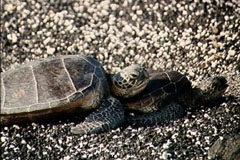
Honu. Green sea turtle. Hawai'i. Photo©CLCase
Subsurface
Bacteria Project
Christine L. Case

Honu. Green sea turtle. Hawai'i. Photo©CLCase |
Subsurface
Bacteria Project
|
The subsurface microbial community constitutes a large fraction of the Earth's biomass, yet only a small fraction of it has been characterized. The microbiology above 50m depth has been examined in various environments by many groups, but similar students of deeper strata have been few and far between despite the interesting findings they have generated. The U.S. Department of Energy established the Deep Microbiology Program in 1986 to promote basic research on the microbiology of terrestrial subsurface environments. Over the next decade, microorganisms were successfully cultured and studies from many sites across the United States and scientists began to realize that these isolates might be a unique and valuable resource. The cultures are preserved in the Subsurface Microbial Culture Collection (SMCC)Skyline College students have been characterizing isolates from the SMCC. |
| Savannah River Borehole 24 (Aiken, South Carolina) | |||||||||
|---|---|---|---|---|---|---|---|---|---|
Culture # |
Stratum |
Depth |
Gram rxn |
Morphology |
Lipase |
Metabolism* |
Oxidase |
Catalase |
|
B258 |
Congaree Aquifer |
299' |
+ |
coccus |
+ |
F |
+ |
+ |
|
B450 |
PeeDee Aquifer |
592' |
- |
rod |
+ |
O |
- |
+ |
|
B451 |
PeeDee Aquifer |
592' |
+ |
coccus |
+ |
N |
- |
+ |
|
B528 |
Black Creek |
668' |
- |
rod |
+ |
F |
+ |
+ |
|
B623 |
Middendorf Aquifer |
802' |
- |
rod |
+ |
F |
+ |
+ |
Pseudomonas |
B666 |
Middendorf Aquifer |
851' |
- |
rod |
+ |
N |
- |
- |
Comamonas |
+F=fermentative; O=oxidative; N=neither oxidative nor fermentative |
|||||||||
Hanford Borehole YB-02 (Richland, Washington |
|||||||||
|---|---|---|---|---|---|---|---|---|---|
Culture # |
Stratum |
Depth |
Gram rnx |
Morphology |
Lipase |
Metabolism |
Oxidase |
Catalase |
|
G884 |
Lacustrine sediments |
598.1' |
+ |
coccus |
+ |
|
|
|
|
G886 |
Lacustrine sediments |
600.6' |
+ |
coccus |
|
|
|
|
Staphylococcus aureus |
G929 |
Fluvial sand |
643.9' |
- |
coccus |
[Grew on 7.5% NaCl, mannitol -, coagulase-] |
||||
G946 |
Fluvial sand |
643.9' |
- |
coccus |
- |
|
|
|
|
G085 |
Fluvial sand |
648.3' |
- |
rod |
+ |
O |
- |
+ |
|
G990 |
Fluvial sand |
643.9' |
- |
rod |
[anaerobe} |
|
|
|
|
G994 |
Fluvial sand |
648.3' |
+ |
rod |
|
|
|
|
|
+F=fermentative; O=oxidative; N=neither oxidative nor fermentative |
|||||||||
|
Fliermans, C. B. and D. L. Balkwill. "Microbial life in deep terrestrial subsurfaces." BioScience 39 (6):370-377, 1989. Fredrickson, J. K., D. L. Balkwill, G. R. Drake, M. F. Romine, D. B. Ringelberg, and D. C. White. "Aromatic-Degrading Sphingomonas isolates from the deep subsurface." Applied and Environmental Microbiology 61:1917-1922, May 1995. Fredrickson, J. K. and T. C. Onstott. "Microbes deep inside the Earth." Scientific American Oct. 1996. Krumholz, L. R. "Microbial Ecosystemsin the Earth's Subsurface." ASM News 64(4):197-202, 1998. Phelps, T. J., E. G. Raione, D. C. White, and C. B. Fliermans. Microbial activities in deep subsurface environments. Geomicrobiology Journal 7:79-91, 1989. |
Look for degradative abilities in one or more isolate. E.g., can any degrade specific hydrocarbon pollutants including pesticides and benzene, toluene, and xylene. Will hydrolytic enzymes work at ambient or cold temperatures for industrial processes. E.g., lipase for laundry detergents. Look for antimicrobics made by subsurface bacteria. |
![]()